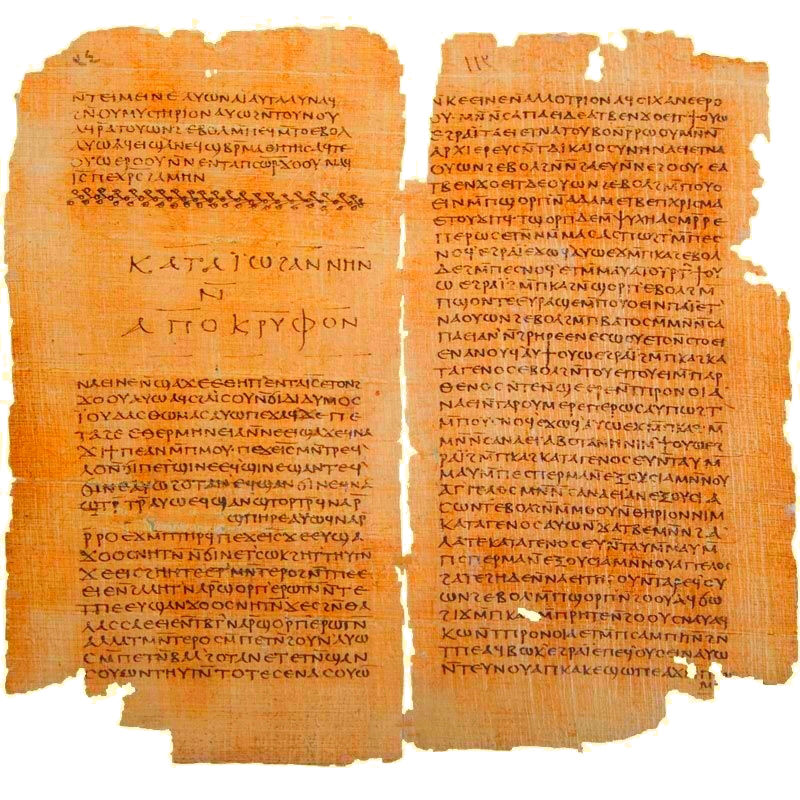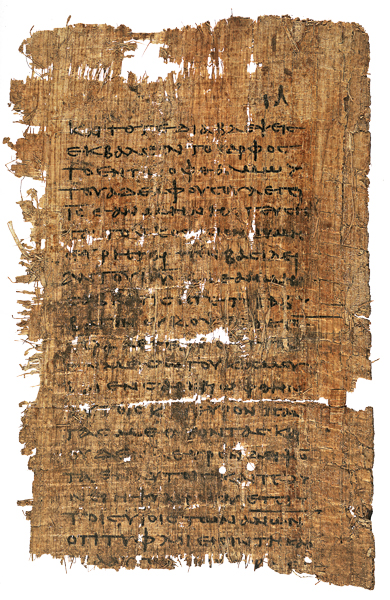Gospel of Thomas: Difference between revisions
No edit summary |
mNo edit summary |
||
| (9 intermediate revisions by the same user not shown) | |||
| Line 1: | Line 1: | ||
Because this Paul organised the religion: the Christian Religion – you cannot organise religion – and so the whole idea of ascent, of a higher life, was lost. Also Paul fought with Matthew, and Thomas ran away to India. But if you read Thomas’ treatise, you will be surprised – he has talked of Sahaj only, everything about Sahaj. (HH Shri Mataji Nirmala Devi, Public Program, Amsterdam, Holland, July 2, 1992) | |||
The ''Gospel of Thomas'' found at Nag Hammadi is in Coptic and likely to have been | |||
[[File:Gospel_of_Thomas_Nag_Hammadi.png]] | |||
[[Thomas]] travelled to India via Egypt, probably visiting the great Hellenic city of Alexandria, and left his eye-witness account of the life of Jesus, most likely in oral form, with local Greek-speaking Jews. The Greek text of the ''Gospel of Thomas'' survives in three fragmentary copies, all found in Egypt, the earliest dated to c.120CE. The ''Gospel of Thomas'' found at Nag Hammadi (also in Egypt) is in Coptic and likely to have been translated from the earlier Greek text sometime in the early 4th century. | |||
[[File:P._Oxy._1.jpg]] | |||
Most modern scholars regard the ''Gospel of Thomas'' as being a text that developed during the first and early second centuries CE within an environment that was primarily oral rather than written. One view, increasingly discredited, is that it was in Edessa (in Syria) that the ''Gospel of Thomas'', written in Greek, may have reached its present form, c.120CE. [http://aprildeconick.com/gospel-of-thomas-articles]. The alternative hypothesis is that Thomas, on his way to India, visited Alexandria, the great Hellenic city in Egypt, and left his eye-witness account, probably in oral form, with local Greek-speaking Jews. [https://www.academia.edu/39572778/Where_Indeed_Was_the_Gospel_of_Thomas_Written_Thomas_in_Alexandria] | |||
Bibliography: Stevan Davies, ''The Gospel of Thomas: annotated and explained'' (Woodstock, VT: SkyLight Paths Publishing, 2002); April D. DeConick, ''The original Gospel of Thomas in translation, with a commentary and new English translation of the complete Gospel'' (London: T & T Clark, 2006); Ian Brown, 'Where Indeed Was the Gospel of Thomas Written? Thomas in Alexandria' ''Journal of Biblical Literature'' 138(2), 2019:451-472; Christopher W.Skinner, 'Gospel of Thomas' ''e-Clavis: Christian Apocrypha'' Accessed Oct 8, 2019 [https://www.nasscal.com/e-clavis-christian-apocrypha/gospel-of-thomas] | |||
Latest revision as of 07:23, 21 December 2021
Because this Paul organised the religion: the Christian Religion – you cannot organise religion – and so the whole idea of ascent, of a higher life, was lost. Also Paul fought with Matthew, and Thomas ran away to India. But if you read Thomas’ treatise, you will be surprised – he has talked of Sahaj only, everything about Sahaj. (HH Shri Mataji Nirmala Devi, Public Program, Amsterdam, Holland, July 2, 1992)
Thomas travelled to India via Egypt, probably visiting the great Hellenic city of Alexandria, and left his eye-witness account of the life of Jesus, most likely in oral form, with local Greek-speaking Jews. The Greek text of the Gospel of Thomas survives in three fragmentary copies, all found in Egypt, the earliest dated to c.120CE. The Gospel of Thomas found at Nag Hammadi (also in Egypt) is in Coptic and likely to have been translated from the earlier Greek text sometime in the early 4th century.
Most modern scholars regard the Gospel of Thomas as being a text that developed during the first and early second centuries CE within an environment that was primarily oral rather than written. One view, increasingly discredited, is that it was in Edessa (in Syria) that the Gospel of Thomas, written in Greek, may have reached its present form, c.120CE. [1]. The alternative hypothesis is that Thomas, on his way to India, visited Alexandria, the great Hellenic city in Egypt, and left his eye-witness account, probably in oral form, with local Greek-speaking Jews. [2]
Bibliography: Stevan Davies, The Gospel of Thomas: annotated and explained (Woodstock, VT: SkyLight Paths Publishing, 2002); April D. DeConick, The original Gospel of Thomas in translation, with a commentary and new English translation of the complete Gospel (London: T & T Clark, 2006); Ian Brown, 'Where Indeed Was the Gospel of Thomas Written? Thomas in Alexandria' Journal of Biblical Literature 138(2), 2019:451-472; Christopher W.Skinner, 'Gospel of Thomas' e-Clavis: Christian Apocrypha Accessed Oct 8, 2019 [3]

